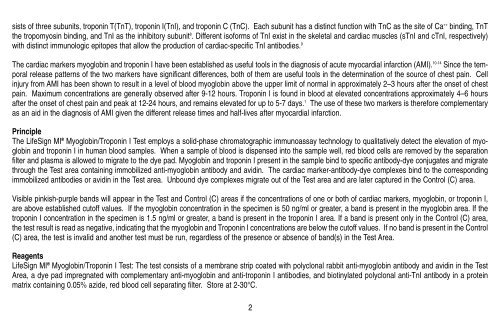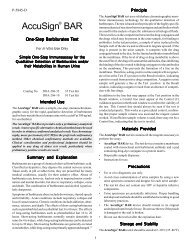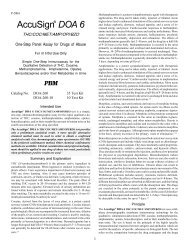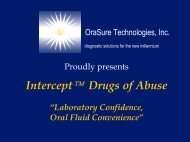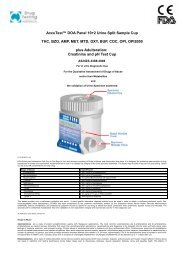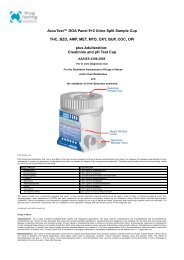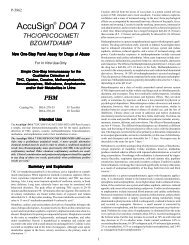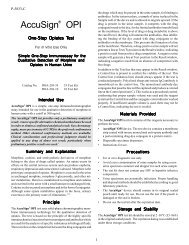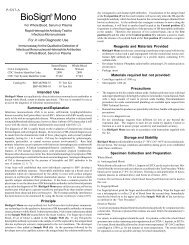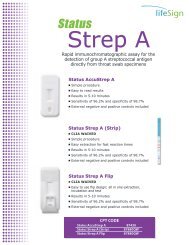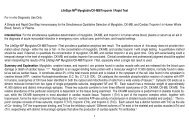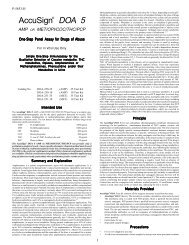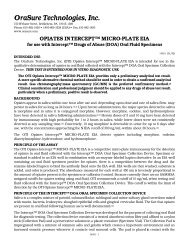LifeSign MI Troponin I/Myoglobin.pdf - Drug Testing
LifeSign MI Troponin I/Myoglobin.pdf - Drug Testing
LifeSign MI Troponin I/Myoglobin.pdf - Drug Testing
Create successful ePaper yourself
Turn your PDF publications into a flip-book with our unique Google optimized e-Paper software.
sists of three subunits, troponin T(TnT), troponin I(TnI), and troponin C (TnC). Each subunit has a distinct function with TnC as the site of Ca ++ binding, TnT<br />
the tropomyosin binding, and TnI as the inhibitory subunit 8 . Different isoforms of TnI exist in the skeletal and cardiac muscles (sTnI and cTnI, respectively)<br />
with distinct immunologic epitopes that allow the production of cardiac-specific TnI antibodies. 9<br />
The cardiac markers myoglobin and troponin I have been established as useful tools in the diagnosis of acute myocardial infarction (A<strong>MI</strong>). 10-14 Since the temporal<br />
release patterns of the two markers have significant differences, both of them are useful tools in the determination of the source of chest pain. Cell<br />
injury from A<strong>MI</strong> has been shown to result in a level of blood myoglobin above the upper limit of normal in approximately 2–3 hours after the onset of chest<br />
pain. Maximum concentrations are generally observed after 9-12 hours. <strong>Troponin</strong> I is found in blood at elevated concentrations approximately 4–6 hours<br />
after the onset of chest pain and peak at 12-24 hours, and remains elevated for up to 5-7 days. 1 The use of these two markers is therefore complementary<br />
as an aid in the diagnosis of A<strong>MI</strong> given the different release times and half-lives after myocardial infarction.<br />
Principle<br />
The <strong>LifeSign</strong> <strong>MI</strong> ® <strong>Myoglobin</strong>/<strong>Troponin</strong> I Test employs a solid-phase chromatographic immunoassay technology to qualitatively detect the elevation of myoglobin<br />
and troponin I in human blood samples. When a sample of blood is dispensed into the sample well, red blood cells are removed by the separation<br />
filter and plasma is allowed to migrate to the dye pad. <strong>Myoglobin</strong> and troponin I present in the sample bind to specific antibody-dye conjugates and migrate<br />
through the Test area containing immobilized anti-myoglobin antibody and avidin. The cardiac marker-antibody-dye complexes bind to the corresponding<br />
immobilized antibodies or avidin in the Test area. Unbound dye complexes migrate out of the Test area and are later captured in the Control (C) area.<br />
Visible pinkish-purple bands will appear in the Test and Control (C) areas if the concentrations of one or both of cardiac markers, myoglobin, or troponin I,<br />
are above established cutoff values. If the myoglobin concentration in the specimen is 50 ng/ml or greater, a band is present in the myoglobin area. If the<br />
troponin I concentration in the specimen is 1.5 ng/ml or greater, a band is present in the troponin I area. If a band is present only in the Control (C) area,<br />
the test result is read as negative, indicating that the myoglobin and <strong>Troponin</strong> I concentrations are below the cutoff values. If no band is present in the Control<br />
(C) area, the test is invalid and another test must be run, regardless of the presence or absence of band(s) in the Test Area.<br />
Reagents<br />
<strong>LifeSign</strong> <strong>MI</strong> ® <strong>Myoglobin</strong>/<strong>Troponin</strong> I Test: The test consists of a membrane strip coated with polyclonal rabbit anti-myoglobin antibody and avidin in the Test<br />
Area, a dye pad impregnated with complementary anti-myoglobin and anti-troponin I antibodies, and biotinylated polyclonal anti-TnI antibody in a protein<br />
matrix containing 0.05% azide, red blood cell separating filter. Store at 2-30°C.<br />
2


